clock DATSUN PICK-UP 1977 User Guide
[x] Cancel search | Manufacturer: DATSUN, Model Year: 1977, Model line: PICK-UP, Model: DATSUN PICK-UP 1977Pages: 537, PDF Size: 35.48 MB
Page 200 of 537
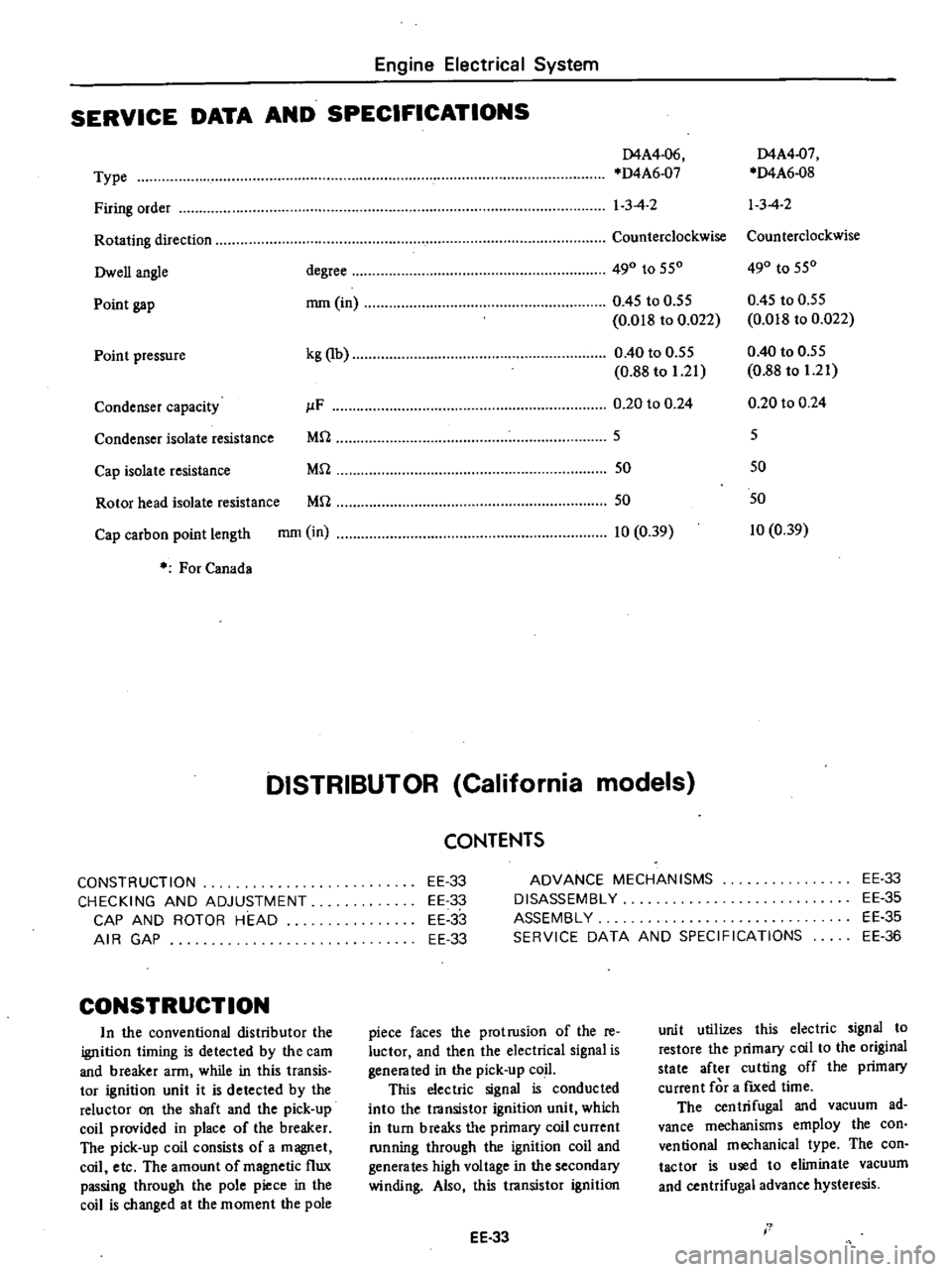
Engine
Electrical
System
SERVICE
DATA
AND
SPECIFICATIONS
D4A4
06
D4A4
07
Type
D4A6
07
D4A6
08
Firing
order
1
3
4
2
13
4
2
Rotating
direction
Counterclockwise
Counterclockwise
Owen
angle
degree
490
to
550
490
to
550
Point
gap
mm
in
0
45
to
0
55
0
45
to
0
55
0
018
to
0
022
0
018
to
0
022
Point
pressure
kg
lb
0
40
to
0
55
0
40
to
0
55
0
88
to
1
21
0
88
to
1
21
Condenser
capacity
JlF
0
20
to
0
24
0
20
to
0
24
Condenser
isolate
resistance
Mrl
5
5
Cap
isolate
resistance
Mrl
50
50
Rotor
head
isolate
resistance
Mrl
50
50
Cap
carbon
point
length
mm
in
10
0
39
10
0
39
For
Canada
DISTRIBUTOR
California
models
CONSTRUCTION
CHECKING
AND
ADJUSTMENT
CAP
AND
ROTOR
HEAD
AIR
GAP
CONSTRUCTION
In
the
conventional
distributor
the
ignition
liming
is
detected
by
the
cam
and
breaker
arm
while
in
this
transis
tor
ignition
unit
it
is
detected
by
the
reluctor
on
the
shaft
and
the
pick
up
coil
provided
in
place
of
the
breaker
The
pick
up
coil
consists
of
a
magnet
coil
etc
The
amount
of
magnetic
flux
passing
through
the
pole
piece
in
the
coil
is
changed
at
the
moment
the
pole
CONTENTS
EE
33
EE
33
EE
33
EE
33
ADVANCE
MECHANISMS
DISASSEMBLY
ASSEMBLY
SERVICE
DATA
AND
SPECIFICATIONS
EE
33
EE
35
EE
35
EE
36
piece
faces
the
protrusion
of
the
re
luctor
and
then
the
electrical
signal
is
genera
ted
in
the
pick
up
coil
This
electric
signal
is
conducted
into
the
transistor
ignition
unit
which
in
turn
breaks
tI
e
primary
coil
current
running
through
the
ignition
coil
and
generates
high
voltage
in
the
secondary
winding
Also
this
transistor
ignition
EE
33
unit
utilizes
this
electric
signal
to
restore
the
primary
coil
to
the
original
state
after
cutting
off
the
primary
current
for
a
fIXed
time
The
centrifugal
and
vacuum
ad
vance
mechanisms
employ
the
con
ventional
mechanical
type
The
con
tactor
is
used
to
eliminate
vacuum
and
centrifugal
advance
hysteresis
I
Page 203 of 537

EE299
Fig
EE
74
Driving
in
roll
pin
Engine
Electrical
System
4
Apply
grease
to
the
top
of
rotor
shaft
as
required
5
Check
the
operation
of
governor
before
installing
distributor
on
engine
6
Adjust
ignition
timing
after
distri
butor
is
installed
on
engine
SERVICE
DATA
AND
SPECIFICATIONS
Type
Firing
order
Rotating
direction
Duty
Air
gap
mm
in
MU
Cap
insulation
resistance
Rotor
head
insulation
resistance
MU
Cap
carbon
point
length
mm
in
D4F4
03
D4F4
04
1
3
4
2
Counterclockwise
70
20
to
40
at
idling
0
2
to
0
4
O
OOS
to
0
016
More
than
50
More
than
50
10
0
39
TRANSISTOR
IGNITION
UNIT
California
models
DESCRIPTION
TRANSISTOR
IGNITION
UNIT
REMOVAL
AND
INSTALLATION
INSPECTION
1
POWER
SUPPLY
WI
RING
AND
BATTERY
CHECK
DESCRIPTION
TRANSISTOR
IGNITION
UNIT
The
transistor
ignition
unit
provides
the
following
functions
L
It
makes
and
breaks
the
electric
current
in
the
primacy
circuit
of
the
ignition
coil
2
CONTINUITY
CHECK
OF
PRIMARY
CIRCUIT
3
PICK
UP
COIL
CONTINUITY
CHECK
4
PICK
UP
COIL
POWER
SIGNAL
PULSE
CHECK
5
TRANSISTOR
IGNITION
UNIT
CHECK
CONTENTS
EE
36
EE
36
EE
37
EE
37
EE
37
2
The
duty
control
circuit
sets
the
rate
of
make
and
break
within
one
cycle
i
e
this
maintains
good
ignition
characteristics
of
engine
from
low
speed
to
high
speed
and
is
equal
to
the
dweU
angle
in
the
conventional
breaker
type
distributor
3
A
preventive
circuit
against
lock
EE
36
EE
36
EE
38
EE
38
EE
39
ing
is
provided
This
cuts
off
the
prilnaCY
electric
current
in
the
ignition
coil
when
the
ignition
switch
is
turned
on
with
the
engine
not
running
Each
component
part
of
this
unit
is
highly
reliable
however
should
any
part
be
found
faulty
the
entire
assem
bly
must
be
replaced
Page 276 of 537

R
RANGE
REVERSE
In
R
range
the
front
clutch
and
the
low
and
reverse
brake
are
applied
The
power
flow
is
through
the
input
shaft
front
clutch
and
connecting
shell
to
the
sun
gear
Clockwise
rota
tion
of
the
sun
gear
causes
counter
clockwise
rotation
of
the
rear
planeta
ry
gears
With
the
connecting
drum
held
stationary
by
the
low
and
reverse
brake
the
rear
planetary
gears
rotate
the
rear
internal
gear
and
drive
the
flange
counterclockwise
The
rear
drive
flange
splined
to
the
output
shaft
rotates
the
output
shaft
counterclock
wise
at
a
reduced
speed
with
an
increase
in
torque
for
reverse
gear
Automatic
Transmission
R
Fig
AT
26
Power
tranamis
ion
during
R
range
m
i
1
A
TOBS
Fig
A
T
21
Optrationof
each
mechanism
during
R
range
When
the
manual
valve
V
is
posi
Clutch
Low
Band
servo
One
tioned
at
R
range
the
oil
having
the
Gear
Partina
Ranae
re
ne
way
line
pressure
7
is
directed
to
line
ralio
Front
Rear
brake
Openlion
Relulie
clutch
plwl
pressure
circuits
5
and
6
The
pressure
in
the
circuit
5
actuates
the
Park
on
on
low
and
reverse
brake
after
being
Ruene
2
182
on
on
on
introduced
into
line
pressure
circuit
Neutral
12
through
the
I
st
2nd
shift
valve
ID
The
pressure
in
the
circuit
op
DI
Low
2
458
on
on
erates
the
release
side
of
the
band
servo
and
the
front
c1u
tch
after
being
Driowe
D2
Second
1
458
on
on
led
to
line
pressure
circuit
0
D3
Top
1
000
on
on
on
through
the
2nd
3rd
shift
valve
@
2
Second
1
458
The
throttle
pressure
I
6
and
the
line
on
on
pressure
6
which
vary
with
the
12
Second
S8
on
on
degree
of
accelerator
pedal
depression
II
Low
2
458
both
act
the
pressure
regulator
on
on
on
valve
CD
and
press
against
its
valve
CD
increasing
line
pressure
7
In
Rn
range
the
governor
pressure
is
absent
making
all
such
valves
as
the
1st
2nd
shift
valve
ID
lnd
3rd
shift
valvc
@
and
pressurc
modifier
valve
inoperative
AT16
Page 280 of 537

Automatic
Transmission
R
RANGE
REVERSE
R
In
R
range
the
front
dutch
and
the
low
and
reverse
brake
are
applied
The
power
flow
is
through
the
input
shaft
front
clutch
and
connecting
shell
to
the
sun
gear
Clockwise
rota
tion
of
the
sun
gear
causes
counter
clockwise
rotation
of
the
rear
planeta
ry
gears
With
the
connecting
drum
held
Slationary
by
the
low
and
reverse
brake
the
rear
planetary
gears
rotate
the
rear
internal
gear
and
drive
the
flange
counterclockwise
The
rear
drive
flange
splined
to
the
output
shaft
rotates
the
output
shaft
counterclock
wise
at
a
reduced
speed
with
an
increase
in
torque
for
reverse
gear
f
When
Ihe
manual
valve
CV
is
posi
tioned
at
R
range
Ihe
oil
having
Ihe
line
pressure
7
is
directed
to
line
pressure
circuits
5
and
6
The
pressure
in
the
circuit
5
actuates
the
low
and
reverse
brake
after
being
introduced
into
line
pressure
circuit
12
through
the
I
st
2nd
shift
valve
@
The
pressure
in
Ihe
circuit
op
erates
the
release
side
of
the
band
servo
and
the
front
clutch
after
being
led
to
line
pressure
circuit
10
through
the
2nd
3rd
shift
valve
@
The
throtlle
pressure
16
and
the
line
pressure
6
which
vary
with
the
degree
of
acceJerator
pedal
depression
both
act
on
the
prcssure
regulator
valve
CD
and
press
against
its
valve
CD
increasing
line
pressure
7
In
R
range
the
governor
pressure
is
absent
making
all
slldl
valves
as
the
J
SI
2nd
shift
valve
@
2nd
3rd
shift
valvc
@
and
pressure
modifier
valve
j
inoperative
C
Fig
AT
26
Power
transmi
ion
during
R
range
A
TOS5
Fig
AT
27
Operation
attach
mechanism
during
R
range
G
Clutch
Low
A
Band
servo
One
Parkin
Ran
no
wa
plwl
ratio
Front
Rear
brake
Operllioo
Rdr
ue
clutch
k
on
on
Revctte
1
181
on
on
on
Neutnl
DI
Low
1
418
on
on
Driw
D2
Second
1
458
on
on
DJ
Top
1
000
on
on
on
on
2
Second
1
458
on
on
12
Second
1
458
on
on
I
II
Low
2
458
on
on
AT
16
Page 284 of 537
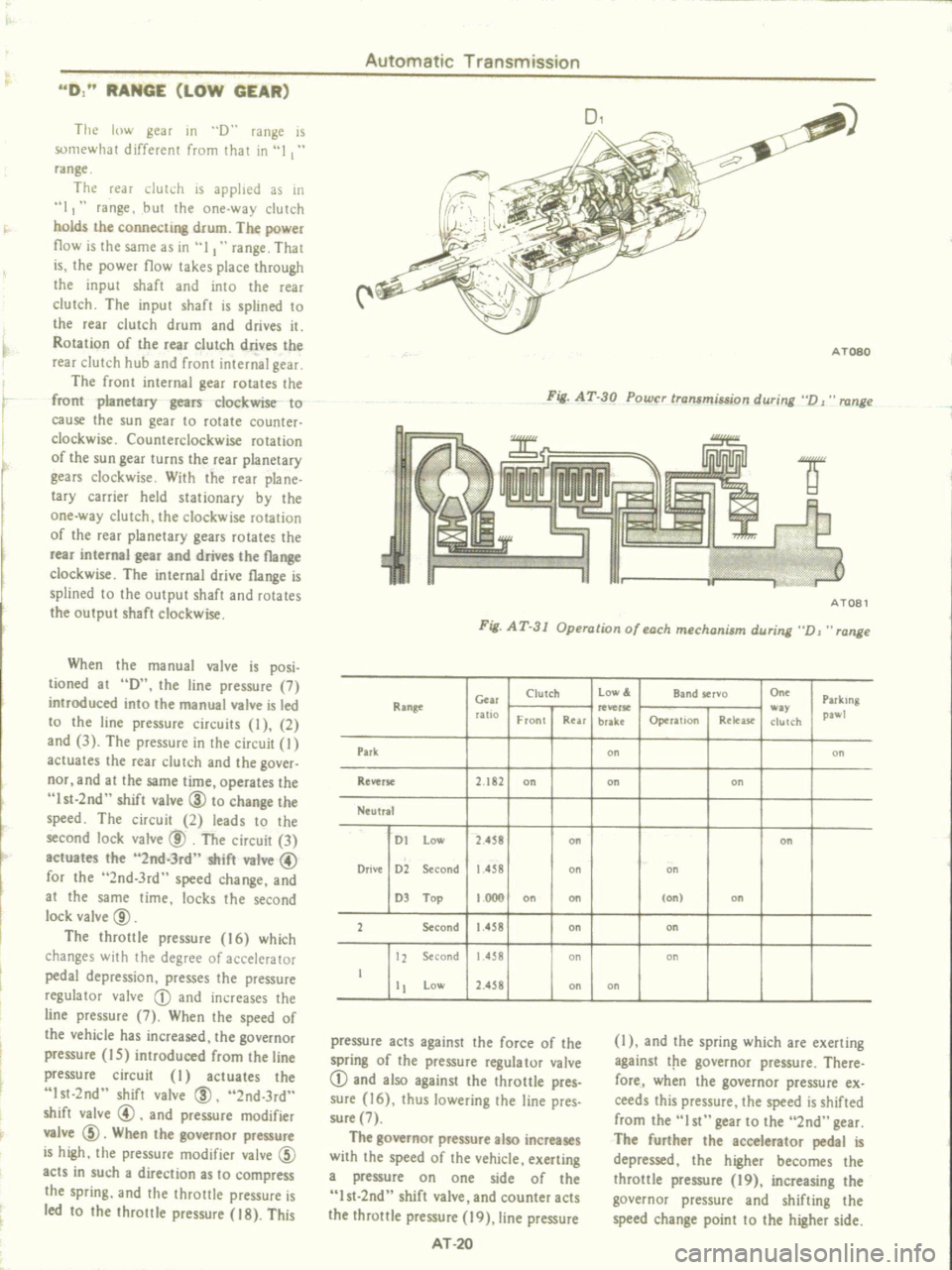
D
RANGE
LOW
GEAR
Automatic
Transmission
The
low
gear
in
D
range
is
somewhat
different
from
that
in
I
range
The
rear
c1utdl
is
applied
as
III
I
range
but
the
one
way
clutch
holds
the
connecting
drum
The
power
now
is
the
same
as
in
1
J
range
That
is
the
power
now
takes
place
through
Ihe
input
shaft
and
into
the
rear
clutch
The
input
shaft
is
splined
to
the
rear
clutch
drum
and
drives
it
Rotation
of
Ihe
rear
clutch
drives
the
rear
clutch
hub
and
front
internal
gear
The
front
internal
gear
rotales
the
front
planetary
gears
clockwise
to
cause
the
sun
gear
to
rotate
counter
clockwise
Counterclockwise
rotation
of
the
sun
gear
turns
the
rear
planetary
gears
clockwise
With
the
rear
plane
tary
carrier
held
stationary
by
the
one
way
clutch
the
clockwise
rotation
of
the
rear
planetary
gears
rotates
the
rear
internal
gear
and
drives
the
flange
clockwise
The
internal
drive
flange
is
splined
to
the
outpul
shaft
and
rotates
the
output
shaft
clockwise
When
the
manual
valve
is
posi
tioned
at
D
the
line
pressure
7
introduced
into
the
manual
valve
is
led
to
the
line
pressure
circuits
l
2
and
3
The
pressure
in
the
circuit
I
acluates
the
rear
clutch
and
the
gover
nor
and
al
the
same
time
operates
the
1st
2nd
shift
valve
CID
to
change
the
speed
The
circuit
2
leads
to
the
second
lock
valve
@
The
circuit
3
actuates
the
2nd
3rd
shift
valve
@
for
the
2nd
3rd
speed
change
and
at
the
same
lime
locks
the
second
lock
valve
@
The
throttle
pressure
16
which
changes
with
the
degree
of
accelerator
pedal
depression
presses
Ihe
pressure
regulator
valve
CD
and
increases
the
line
pressure
7
When
Ihe
speed
of
the
vehicle
has
increased
the
governor
pressure
15
introduced
from
the
line
pressure
circuit
I
actuates
the
I
SI
2nd
shift
valve
CID
2nd
3rd
shift
valve
@
and
pressure
modifier
valve
ID
When
the
governor
pressure
is
high
the
pressure
modifier
valve
ID
acls
in
such
a
direction
as
to
compress
the
spring
and
the
throttle
pressure
is
led
to
the
throttle
pressure
18
This
ATOSO
Fig
AT
30
Power
transmission
during
D
J
range
liIIl
I
IW
L
AT08l
Fig
AT
31
Operation
of
each
mechanism
during
VJ
range
Clutch
low
Band
servo
On
Parking
Cur
Ran
Rllelle
way
pawl
ratio
Front
Rur
brake
Operation
Rekase
ch
lch
Park
on
on
RellerK
2
t82
on
on
on
Neutral
01
low
2
S8
on
on
Orivt
02
Second
1
458
on
on
OJ
Top
1000
on
on
on
on
2
Second
1
458
on
00
t2
Second
1
458
on
on
t
tt
low
2
458
on
on
pressure
acts
against
the
force
of
the
spring
of
the
pressure
regulator
valve
CD
and
also
against
the
throttle
pres
sure
16
thus
lowering
the
line
pres
sure
7
The
governor
pressure
also
increases
with
the
speed
of
Ihe
vehicle
exerting
a
pressure
on
one
side
of
the
lst
2nd
shift
valve
and
counter
acts
the
Ihrottle
pressure
19
line
pressure
AT
20
l
and
the
spring
which
are
exerting
against
t
1e
governor
pressure
There
fore
when
the
governor
pressure
ex
ceeds
Ihis
pressure
the
speed
is
shifted
from
the
I
st
gear
to
the
2nd
gear
The
further
the
accelerator
pedal
is
depressed
the
higher
becomes
the
throttle
pressure
19
increasing
the
governor
pressure
and
shifting
the
speed
change
point
to
the
higher
side
Page 286 of 537
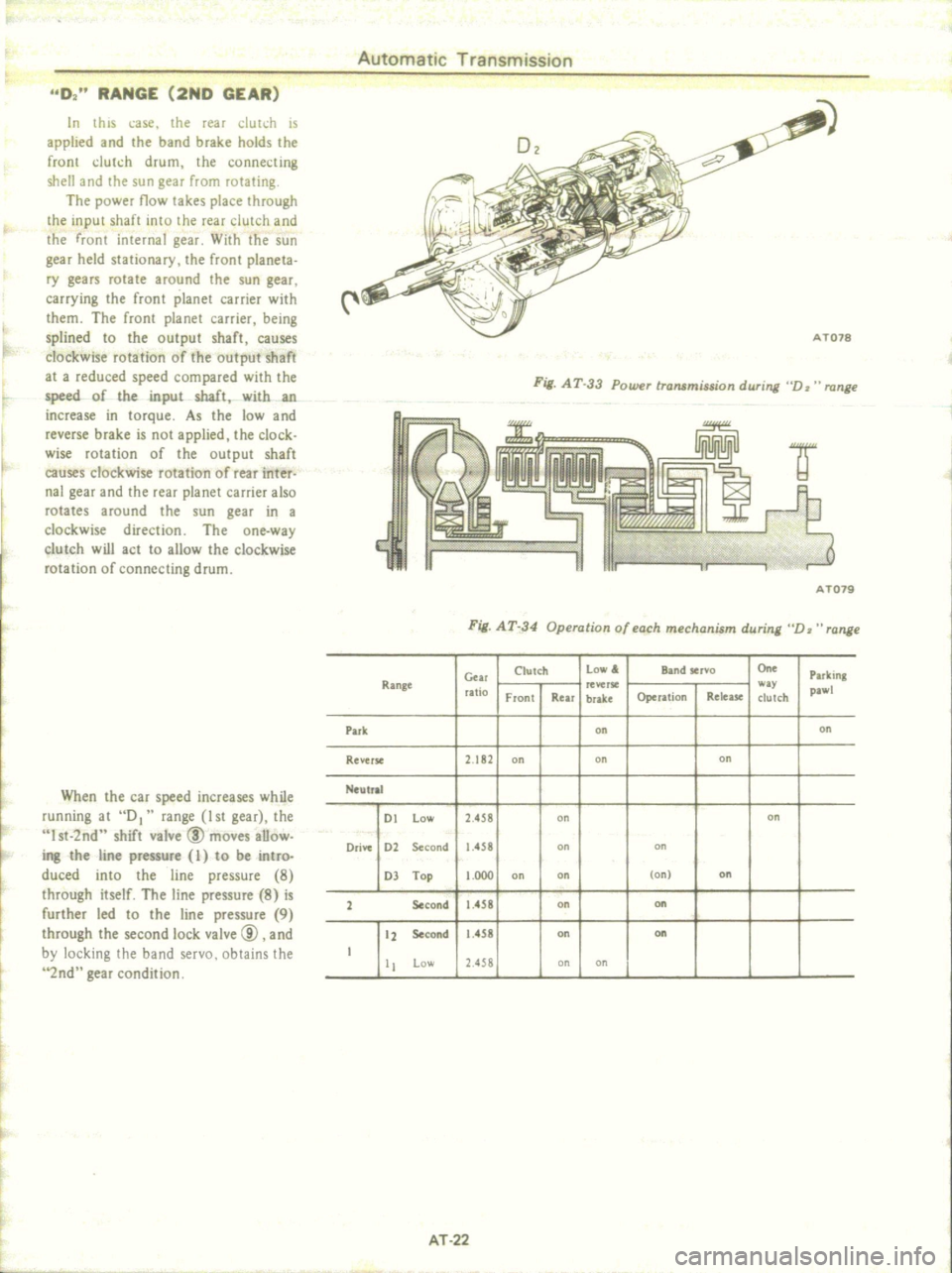
D
RANGE
2ND
GEAR
Automatic
Transmission
t
In
this
case
the
rear
c1ut
h
IS
applied
and
the
band
brake
holds
the
fronl
dUh
h
drum
the
connecting
shell
and
the
sun
gear
from
rotating
The
power
flow
lakes
place
through
the
input
shaft
into
the
rear
clutch
and
the
front
internal
gear
With
the
sun
gear
held
stationary
the
front
planeta
ry
gears
rotate
around
the
sun
gear
carrying
the
front
planet
carrier
with
them
The
fronl
planet
carrier
being
splined
to
the
output
shaft
causes
clockwise
rotation
of
the
output
shaft
at
a
reduced
speed
compared
with
the
speed
of
the
input
shaft
with
an
increase
in
torque
As
the
low
and
reverse
brake
is
not
applied
the
clock
wise
rotation
of
the
output
shaft
causes
clockwise
rotation
of
rear
inter
nal
gear
and
the
rear
planet
carrier
also
rotates
around
the
sun
gear
in
a
clockwise
direction
The
one
way
clutch
will
act
to
allow
the
clockwise
rotation
of
connecting
drum
When
the
car
speed
increases
while
running
at
D
range
I
st
gear
the
st
2nd
shift
valve
ID
moves
allow
ing
the
line
pressure
I
to
be
intro
duced
into
the
line
pressure
8
Ihrough
itself
The
line
pressure
8
is
further
led
to
the
line
pressure
9
through
the
second
lock
valve
@
and
by
locking
the
band
servo
obtains
the
2nd
gear
condition
Fig
AT
33
Power
transmission
during
Dz
range
A
T079
Fig
AT
34
Operation
of
each
mechanism
during
D
range
Clutch
Low
Band
servo
On
Patking
G
Range
reverse
w
pawl
ratio
Fronl
Rur
brake
Optrltion
Release
clutch
PlIk
on
on
Revtne
2
182
on
on
on
Neutral
01
Low
2
4S8
on
on
Drive
02
Second
1
4S8
on
on
OJ
Top
1
000
on
on
on
on
2
Second
1
4S8
on
on
12
Second
1
4S8
on
on
1
II
Low
2
4S8
on
on
AT
22
Page 292 of 537
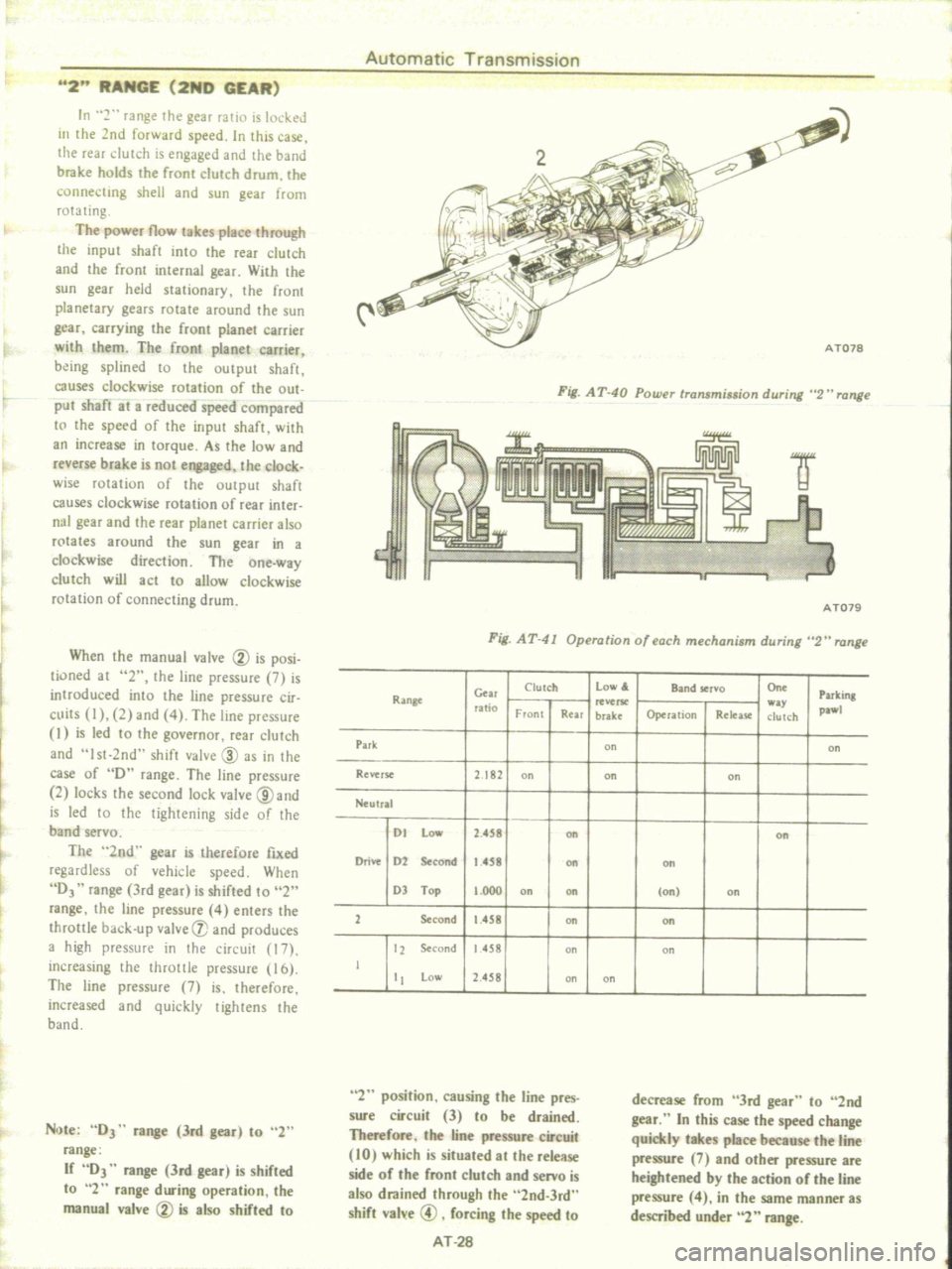
2
RANGE
2ND
GEAR
Automatic
Transmission
In
2
range
the
gear
rario
is
IOI
keJ
III
the
2nd
forward
speed
In
this
case
the
rear
dutch
is
engaged
and
the
band
brake
holds
the
front
clutch
drum
the
connecting
shell
and
sun
gear
from
rotating
The
power
flow
takes
place
through
the
input
shaft
inlo
the
rear
clutch
and
the
front
internal
gear
With
Ihe
sun
gear
held
stationary
the
front
planetary
gears
rotate
around
the
sun
gear
carrying
the
front
planet
carrier
with
them
The
front
planet
carrier
being
splined
to
the
output
shaft
causes
clockwise
rotation
of
the
OUI
put
shaft
at
a
reduced
speed
compared
to
the
speed
of
the
input
shaft
with
an
increase
in
torque
As
the
low
and
reverse
brake
is
not
engaged
the
clock
wise
rotation
of
the
output
shaft
causes
clockwise
rotation
of
fear
inter
nal
gear
and
the
rear
planet
carrier
also
rotates
around
the
sun
gear
in
a
clockwise
direction
The
one
way
clutch
will
act
to
allow
clockwise
rotation
of
connecting
drum
When
the
manual
valve
V
is
posi
tioned
at
2
the
line
pressure
7
is
introduced
into
the
line
pressure
cir
cuits
I
2
and
4
The
line
pressure
I
is
led
to
the
governor
rear
clutch
and
I
st
2nd
shift
valve
CID
as
in
the
case
of
D
range
The
line
pressure
2
locks
the
second
lock
valve
@and
is
led
to
thc
tightening
side
of
Ihe
band
servo
The
2nd
gear
is
therefore
fixed
regardless
of
vehicle
speed
When
DJ
range
3rd
gear
is
shifted
to
2
range
the
line
pressure
4
enters
Ihe
throttle
back
up
valve
V
and
produces
a
high
pressure
in
the
circuit
17
increasing
thc
throttle
pressure
li
6
The
line
pressure
7
is
therefore
increased
and
quickly
tightens
the
band
N
e
DJ
range
3rd
gear
to
2
range
If
DJ
range
3rd
gear
is
shifled
to
2
range
during
operation
the
manual
valve
V
is
also
shifted
to
A
T078
Fig
AT
40
Powu
tTansminion
during
2
H
range
A
1079
Fig
AT
41
Operation
of
each
mechanism
during
2
range
Clutch
Low
Band
ser
o
On
Parking
Gw
Ran8t
utio
w
pa
Front
Rear
brake
Operalion
Release
dutch
Pui
on
on
Revtrs
e
2
182
on
on
on
Neutral
01
Low
2
458
on
on
Drive
02
Second
1
458
Oft
Oft
OJ
Top
1
000
on
on
on
on
1
Second
1
458
on
Oft
12
tocond
1458
on
on
J
tt
Low
2
458
on
on
2
position
causing
the
line
pres
sure
circuit
3
to
be
drained
Therefore
the
line
pressure
circuit
10
which
is
situated
at
the
release
side
of
the
front
clutch
and
servo
is
also
drained
through
the
2nd
3rd
shift
val
e
@
forcing
the
speed
to
AT
28
decrease
from
3rd
gear
to
2nd
gear
In
this
case
the
speed
change
quickly
takes
place
because
the
line
pressure
7
and
other
pressure
are
heightened
by
the
action
of
the
line
pressure
4
in
the
same
manner
as
described
under
2
range
Page 294 of 537
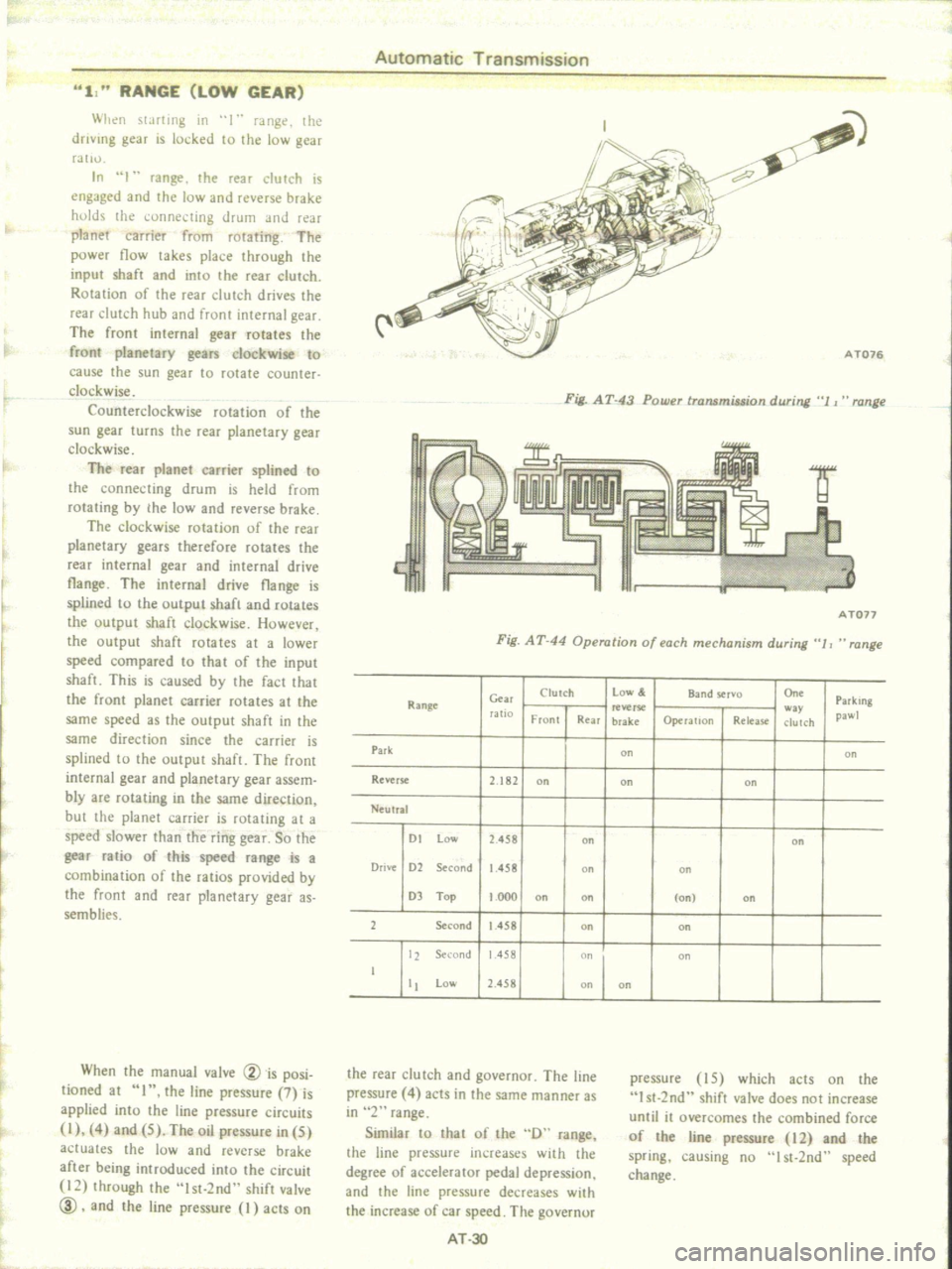
1
RANGE
LOW
GEAR
Automatic
Transmission
f
Wilen
slJrting
in
I
range
the
drlvlIlg
gear
is
IOl
ked
to
the
low
gear
fJIIIJ
In
H
range
the
rear
clutch
is
engJged
and
the
low
and
reverse
brake
hulds
he
onnecting
drum
and
feac
planet
carrier
from
rotating
The
power
tlow
lakes
place
through
the
input
shaft
and
into
lhe
rear
clutch
ROlalion
of
the
rear
clutch
drives
lhe
rear
dutch
hub
and
front
internal
gear
The
front
internal
gear
rotates
the
front
planetary
gears
clockwise
to
cause
the
sun
gear
to
rotate
counter
clockwise
Counterclockwise
rotation
of
the
sun
gear
turns
the
rear
planetary
gear
clockwise
The
rear
planet
carrier
splined
to
the
connecting
drum
is
held
from
rotating
by
the
low
and
reverse
brake
The
clockwise
rotation
of
the
rear
planetary
gears
therefore
rotates
the
rear
internal
gear
and
internal
drive
tlange
The
internal
drive
tlange
is
splined
to
the
output
shaft
and
rotates
the
uutput
shaft
clockwise
However
the
output
shaft
rotates
at
a
lower
speed
compared
to
that
of
the
input
shaft
This
is
caused
by
the
fact
Ihat
the
front
planet
carrier
rotates
at
the
same
speed
as
Ihe
OUlput
shaft
in
the
same
direction
since
the
carrier
is
splined
to
the
output
shaft
The
front
internal
gear
and
planetary
gear
assem
bly
are
rotating
in
the
same
direction
but
the
planet
carrier
is
rotating
at
a
speed
slower
than
the
ring
gear
So
the
gear
ralio
of
this
speed
range
is
a
combination
of
the
ratios
provided
by
the
front
and
rear
planetary
gear
as
semblies
When
the
manual
valve
Vis
posi
tioned
at
I
the
line
pressure
7
is
applied
into
the
line
pressure
circuits
I
4
and
5
The
oil
pressure
in
5
actuates
the
luw
and
reverse
brake
after
being
introduced
into
the
circuit
12
through
Ihe
1st
2nd
shift
valve
ID
and
the
line
pressure
I
acts
on
C
A
T076
Fig
AT
43
Power
transmission
during
1
J
range
Fai1
A
TOn
Fig
AT
44
Operation
of
each
mechanism
during
JJ
range
Clutch
Low
Band
servo
On
Parking
Gm
Range
reverse
w
pawl
ratIO
Front
Rur
brake
Operatlon
Release
clulCh
Park
on
on
Reverse
2
182
on
on
on
Neutral
01
low
2
458
on
on
Drive
02
Second
1
458
on
on
03
Top
1000
on
on
on
on
2
Second
1
458
on
on
2
Second
IAS8
on
on
I
1
low
2
458
on
on
the
rear
clutch
and
governor
The
line
pressure
4
acts
in
the
same
manner
as
in
2
range
Similar
to
that
of
the
D
range
the
line
pressure
inr
reases
with
the
degree
of
accelerator
pedal
depression
and
the
line
pressure
decreases
with
the
increase
of
car
speed
The
governor
pressure
15
which
acts
on
the
I
st
2nd
shift
valve
does
not
increase
until
it
overcomes
the
combined
force
of
the
line
pressure
12
and
the
spring
causing
no
st
2nd
speed
cha
nge
AT
30
Page 303 of 537

Fig
AT
70
Measuring
ring
to
plate
clearance
Available
retaining
plate
Thickness
mm
in
1l
8
0
465
12
0
0472
12
2
0480
124
0488
12
6
0496
12
8
0
504
For
inspection
procedure
for
low
and
reverse
brake
see
page
AT
42
for
Assembly
3
Install
one
way
clutch
so
that
the
arrow
mark
is
toward
front
of
vehicle
It
should
be
free
to
rotate
only
in
clockwise
direction
See
Figure
AT
71
mITIJ
o
oml
AT137
Fig
AT
71
One
way
clutch
4
After
installing
rear
extension
torque
attaching
bolts
to
2
0
to
2
5
kg
m
14
to
18
ft
lb
Place
manual
lever
in
P
range
and
check
to
be
sure
that
rear
output
shaft
is
securely
blocked
5
Tighten
servo
retainer
temporari
ly
at
this
stage
of
assembly
6
Place
rear
clutch
assembly
with
needle
bearing
on
front
assembly
Automatic
Transmission
7
Install
rear
clutch
hub
and
front
planetary
carrier
as
shown
in
Figure
AT
72
AT142
Fig
AT
72
Installing
planetary
carrier
8
Assemble
connecting
shell
and
other
parts
up
to
front
Clutch
in
reverse
order
of
disassembly
AT143
Fig
AT
73
Installing
connecting
shell
9
Adjust
total
end
play
and
front
end
playas
follows
Front
end
play
L
r
L
CD
I
r
L
11
I
J
Total
end
play
@
Front
clutch
thrust
washer
2
Oil
pump
cover
3
Front
clutch
4
Rear
clutch
AT138
5
Trammission
case
6
Oil
pump
gasket
7
Oil
pump
cover
bearing
race
Fig
AT
74
End
play
1
Measure
the
distance
A
and
C
by
vernier
calipers
as
shown
in
Figure
AT
75
AT
39
i
Rear
c
clutch
N
edle
bearing
Bearing
race
I
Fig
AT
75
AT139
Measuring
the
distance
A
and
C
2
Measure
the
distance
B
and
D
of
oil
pump
cover
as
shown
in
Figure
AT
76
I
L
I
Oiipi
mp
AT140
Fig
AT
76
Measuring
the
distance
B
and
D
Adjustment
of
total
end
play
Select
oil
pump
cover
bearing
race
by
calculating
the
following
formula
TT
A
B
W
where
T
T
Required
thickness
of
oil
pump
cover
bearing
race
mm
in
A
Measured
distance
A
mm
in
B
Measured
distance
B
mm
in
W
Thickness
of
bearing
race
temporarily
inserted
mm
in
Available
oil
pump
cover
bearing
race
Thickness
mm
in
1
2
0
047
I
4
0
055
1
6
0
063
1
8
0
071
2
0
0
079
2
2
0
087
Specified
total
end
play
0
25100
50
mm
0
0098
to
0
0197
in
Page 353 of 537

spindle
and
torque
bolt
to
10
3
to
12
1
kg
m
75
to
88
ft
lb
Bend
lock
plate
to
engaged
flats
on
boll
head
Note
When
disassembled
discard
used
lock
plate
5
Pack
grea
to
the
upP
r
and
lower
bushings
on
knuckle
spindle
until
grease
c
omes
out
from
gr
ease
seal
6
Fill
wheel
hub
and
cap
with
grease
up
to
the
described
level
See
Figure
F
A
4
FA141
Fig
FA
4
Gre
ing
wheel
hub
7
Pack
roller
and
cone
assembly
and
the
cavity
of
grease
seal
lip
with
grease
8
Coat
grease
to
the
thread
of
knuckle
spindle
bearing
washer
and
bearing
lock
nul
9
Secure
wheel
hub
bearings
bear
ing
washer
and
spindle
nut
on
knuckle
spindle
and
adju
t
bearing
preload
referring
to
the
paragraph
Wheel
bearing
adjustment
Note
Be
sure
to
obtain
correct
pre
load
on
wheel
bearings
for
the
pu
rpose
of
ving
their
long
life
taking
care
to
keep
wheel
be8rlngs
grease
seal
bearing
washer
and
spin
dle
nut
clean
when
installing
them
WHEEL
BEARING
D
TM
NT
Wrong
adjustment
of
wheel
bear
ing
causes
abnonnal
wear
and
score
on
the
bearings
and
knuckle
spindle
Front
Axle
Front
Suspension
To
attain
proper
preload
on
wheel
bearings
proceed
the
following
opera
tions
I
Torque
spindle
nut
to
3
0
to
3
S
kg
m
22
to
25
ft
lb
using
torque
wrench
FA227
Fig
FA
5
Tightening
apindle
nut
2
Rotate
wheel
hub
a
few
turns
clockwise
and
counterclockwise
to
seat
bearings
Then
retighten
spindle
nut
to
the
same
tightening
torque
Be
certain
to
rotate
hub
smoothly
3
Back
off
spindle
nut
in
range
from
40
to
70
degrees
Locate
adjust
ing
cap
on
spindle
nut
so
as
to
align
the
castellation
on
the
cap
with
the
cotter
pin
hole
in
the
spindle
4
Check
the
hub
rotation
If
hub
rotates
properly
measure
bearing
rota
tion
starting
torque
If
measured
torque
is
deviated
from
the
specified
value
r
place
beari
gs
r
re
dju
st
The
starting
torque
can
be
mea
sured
by
a
spring
balance
as
shown
in
Figure
F
A
6
Spring
balance
indication
at
hub
bolt
New
bearing
2
1
kg
4
Ib
o
ess
Used
bearing
1
0
kg
2
2
lb
or
less
Notes
a
When
measuring
the
starting
force
pull
the
spring
balance
toward
tan
gential
direction
against
normal
line
connected
between
hub
boll
and
spindle
center
b
Axial
play
is
permissible
to
exist
in
0
1
mm
0
004
in
or
less
FA
4
fA22S
Fig
FA
6
Mea
uring
bearing
rotation
atarting
torque
S
Install
a
new
cotter
pin
Bend
the
ends
of
coller
pin
around
the
castel
lated
flange
of
adjusting
cap
Then
install
hub
cap
DISASSEMBLY
AND
ASSEMBLY
Knuckle
spindle
I
Drive
spindle
bushing
and
grease
seal
out
of
knuckle
spindle
with
KiTlg
Pin
Bush
Drift
ST3S380000
Discard
bushing
and
grease
seal
when
disas
sembled
2
After
cleaning
king
pin
bores
thoroughly
install
bushing
carefully
by
using
the
above
special
tpol
Posi
tion
bushing
in
accordance
With
the
instructions
fIlled
in
Figure
F
A
7
and
FA
8
34
mm
1
34
in
Upper
side
in
lower
boss
I
I
1
II
I
Pla
ce
this
position
in
line
with
grease
nipple
hole
Upper
side
in
upper
boss
FA229
Fig
FA
7
King
pin
bu
hing